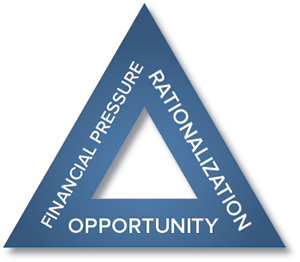Fraud 101: What Is Fraud?
It’s both simpler and more complicated than you think.
The most widely accepted explanation for why some people commit fraud is known as the Fraud Triangle. The Fraud Triangle was developed by Dr. Donald Cressey, a criminologist whose research on embezzlers produced the term “trust violators.”

The Fraud Triangle hypothesizes that if all three components are present — unshareable financial need, perceived opportunity and rationalization — a person is highly likely to pursue fraudulent activities. As Dr. Cressey explains in the Fraud Examiners Manual:
When the trust violators were asked to explain why they refrained from violation of other positions of trust they might have held at previous times, or why they had not violated the subject position at an earlier time, those who had an opinion expressed the equivalent of one or more of the following quotations: (a) ‘There was no need for it like there was this time.’ (b) ‘The idea never entered my head.’ (c) ‘I thought it was dishonest then, but this time it did not seem dishonest at first.’
This short explainer video highlights how the Fraud Triangle is used to explain the reasons why people commit fraud:

Occupational fraud contains a wide variety of specific schemes — each of which with its own tactics and goals. That’s why we created the Fraud Tree, which classifies every type of occupational fraud.
Unfortunately, fraud is so common that it can be categorized in countless ways. But fundamentally, every type of fraud is either organizational or individual. Let’s look at some key characteristics of each.
This is when a single person is targeted by a fraudster — including identity theft, phishing scams and “advance-fee” schemes. Perhaps one of the most noteworthy and devastating individual frauds is the Ponzi scheme.
Sometimes called “occupational fraud,” this is when an employee, manager or executive of an organization deceives the organization itself. Think embezzlement, cheating on taxes, and lying to investors and shareholders.
This includes fraud committed against an organization from the outside, such as vendors who lie about the work they did, demand bribes from employees and rig costs. But customers sometimes defraud organizations, such as when they submit bad checks or try to return knock-off or stolen products. And increasingly, technology threatens organizations with theft of intellectual property or customer information.